1934 Quarter Coin Value: How Much Is It Worth?
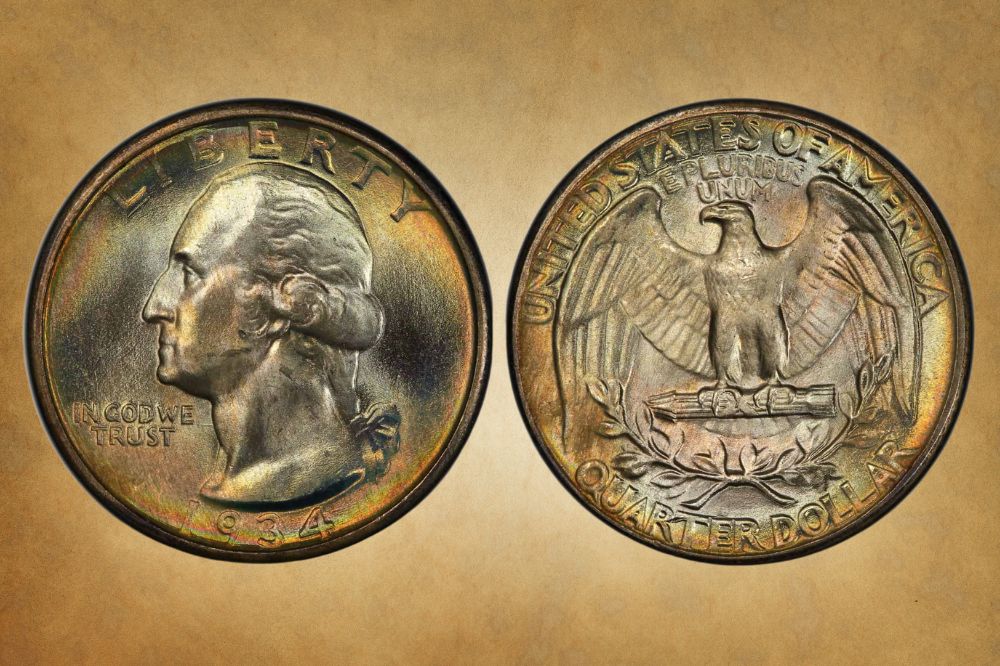
Did you happen upon a 1934 quarter in your pocket change? Well, you just found a coin that could be thousands of dollars!
That’s right—the 1934 quarter value is significantly high partly because of the coin’s silver content and its commemorative and historical value.
These Washington quarters are also quite rare in uncirculated, mint states, making them worth hundreds or thousands of dollars.
If you are curious about the value of your 1934 quarter, you have come to the right place. Read on to learn about the coin’s historical significance, features to identify a high-value quarter, errors and varieties, and of course, the specific value of each variety of the 1934 quarter.
So, let’s get started!
1934 Quarter Value Chart |
||||
| Mint mark | Good | Fine | Extremely Fine | Uncirculated |
| 1934 No-Mint mark Quarter Value | $8 | $10 | $15 | $8,500 |
| 1934-D Mint mark Quarter Value | $10 | $17 | $50 | $7750 |
1934 Quarter Value Guides
In this section, we will learn about the value of your 1934 quarter. Factors such as mintmarks, condition, and grading determine how much your 1934 quarter really is.
The 1934 quarter was only struck at the Philadelphia and Denver mints. The mints produced three varieties of these quarters; the varieties are named after the varying intensity of the motto IN GOD WE TRUST on the various coins.
The three varieties are:
- Light Motto
- Medium Motto
- Heavy Motto
All three varieties of the 1934 quarter were minted in Philly, while only the medium and heavy motto quarters were struck in Denver. The motto’s intensity does not significantly affect the coin’s value.
Let’s now look at the value of the two categories of the 1934 Washington quarters. These include:
The 1934 No-Mintmark Quarter
The 1934 D Quarter
1934 No-Mint mark Quarter Value
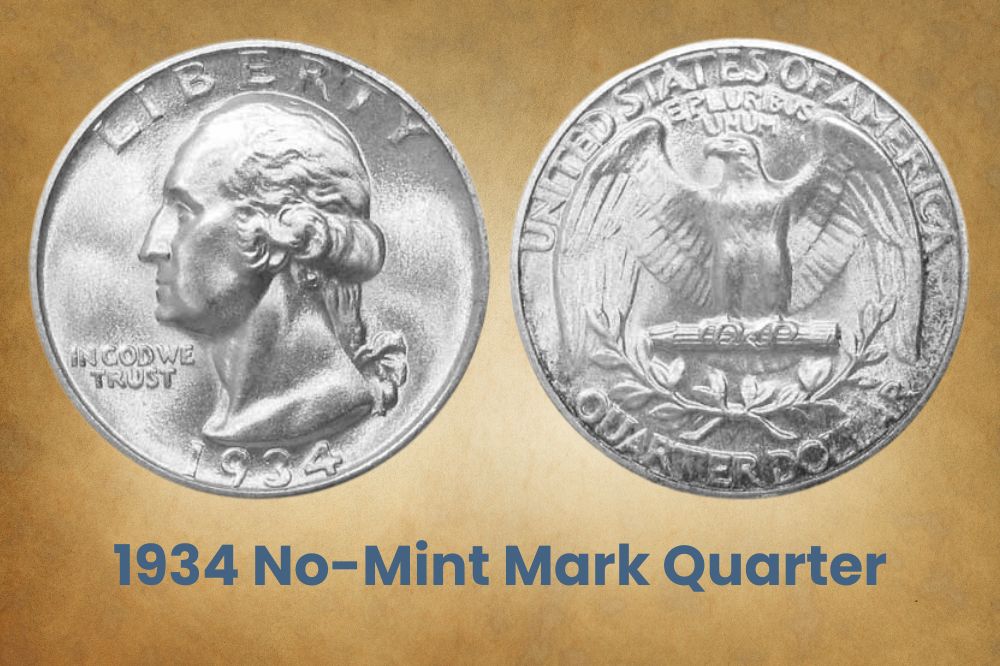
The Philadelphia mint struck an estimated 31,912,052 Washington quarters in 1934. The Mint kept changing the hubs used to strike the coins, resulting in three variations of the 1934 quarter observed on the letters W and WE in the motto IN GOD WE TRUST.
On the low motto quarters, you will notice that the motto IN GOD WE TRUST appears in very low relief. This appearance happened because even in 1934, the mint was still using the old dies it had been using since 1932.
On the Medium Motto quarters, the center stroke on the letter W is shorter than the other two strokes on the left and right. Meanwhile, on the Heavy Motto coins, the center stroke is higher than the other two.
The Medium Motto 1934 quarter is the most common, followed by the Heavy and Light Motto quarters. There are numerous examples of 1934 Washington quarters in mint condition and some in Medium motto. But, Light Motto 1934 quarters are extremely scarce in mint state.
Although the 1934 quarter is composed of 90 percent silver, the coin’s value today is not hinged on its silver content (which is really a tiny amount). The 1934 quarter value is pegged more on its commemorative and historical significance as it features the country’s first president.
In circulated condition, the 1934 Washington quarter is worth between $7.50 and $30, depending on the coin’s condition. The coin can be worth up to $8,500 in mint, uncirculated condition.
The most expensive Light Motto 1934 quarter in grade MS67 sold for $8,813 in 2014. A Medium Motto 1934 quarter in grade MS68 sold at $15,275 in 2013, while a Heavy Motto 1934 Washington quarter in grade MS67 sold for $9,400 in 2022.
1934 D Quarter Value
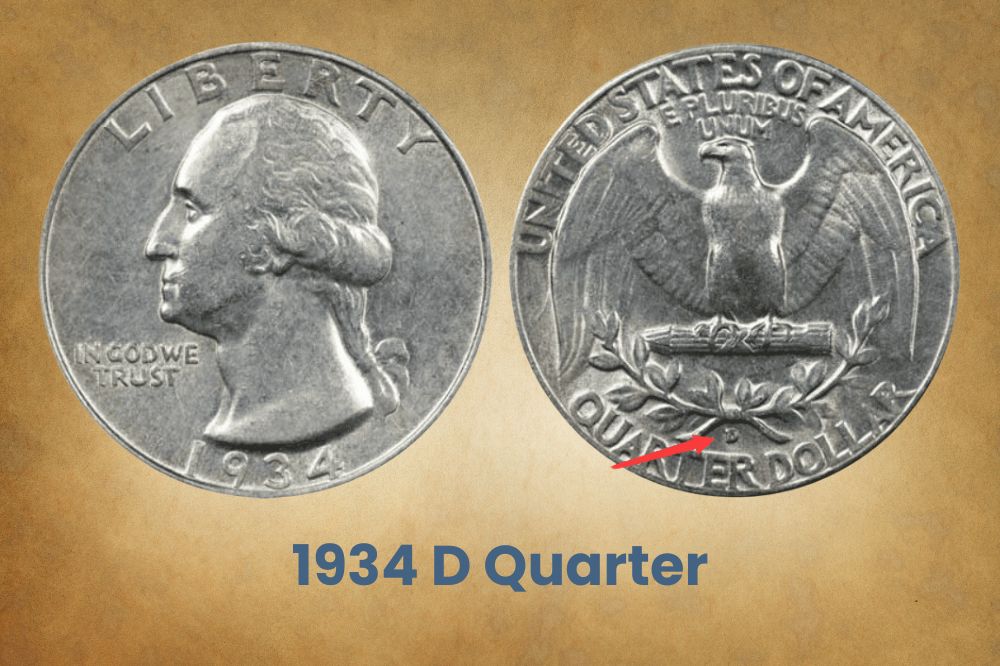
Only 3,527,200 quarters were struck at the Denver mint in 1934. This low mintage can be attributed to the oversupply of Washington quarters in 1932 and low demand in subsequent years.
Two obverse hubs were used at the Denver facility to strike the 1934-D quarters. One die resulted in a Medium Motto coins, which are more common and the other die made the less common Heavy Motto coins.
Other 1934-D Washington quarters spot a small D mintmark, while others have a noticeably larger D mintmark. These differences in size are not errors and do not significantly affect the 1934 quarter value.
All in all, circulated Washington quarters from 1934 are common, while those in mint state are fairly scarce. Few examples of gem certified 1934 quarters are available, which can be worth thousands of dollars.
In circulated condition, the 1934 quarter value is between $8 and $160 depending on the coin’s condition, with circulated but less worn coins attracting a higher value than circulated and worn coins.
In mint, uncirculated condition, your 1934 quarter can fetch up to $7,750. The most expensive 1934 Washington Medium Motto quarter in grade MS67 sold for 21,850 in 2007. A Heavy Motto in MS67 sold at $15,275 in 2013.
Related Posts: 17 Most Valuable Modern Quarters Worth Money
1934 Quarter Errors
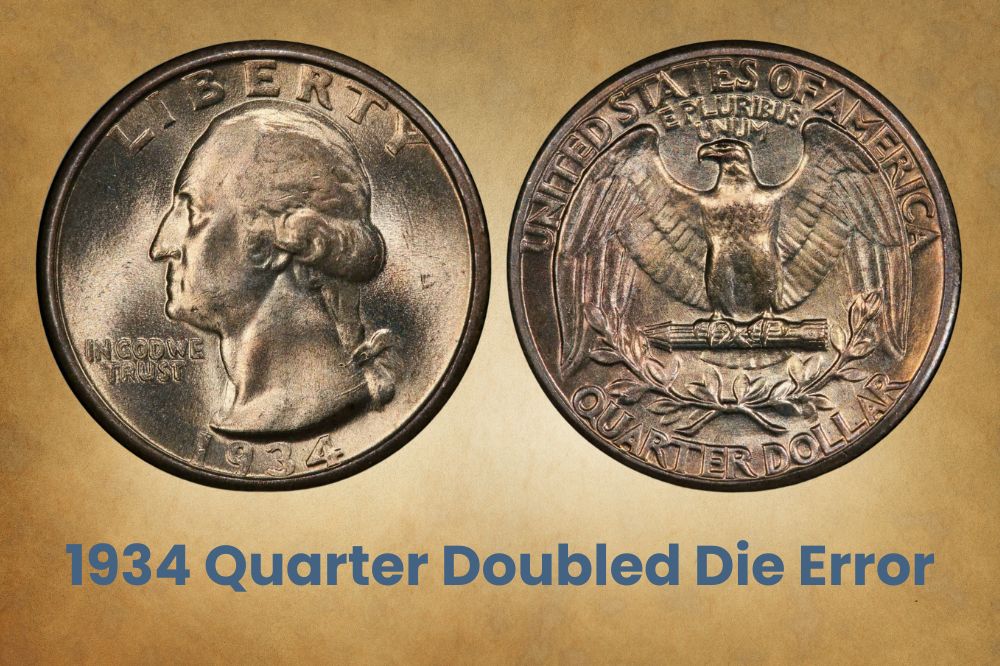
It is not unusual for a coin series to have multiple types of errors. But, the 1934 quarter has only one notable error, i.e., the Doubled Die Error.
While the doubled die error is quite common in many coin series, the value of a coin can shoot up significantly if the doubled die error is strong and easily visible.
In 1934, a few Washington quarters from the Philadelphia mint came out with a strong doubled die error visible on the motto IN GOD WE TRUST on the obverse. The word LIBERTY and the date, 1934, also show subtle doubling.
The 1934 double-die quarter is the most dramatic since the Mint at Philadelphia began striking the Washington quarter series. The other four notable double dies from the Washington quarter series include the 1937 quarter, 1942-D, 1943, and 1943-D. ‘
In 2005 the most expensive 1934 quarter errors graded MS65 sold for $10,350.
Related Posts: 16 Most Valuable Quarter Errors
History Of The 1934 Quarter
The 1934 quarter belonged to the first commemorative coin series issued in 1932 for the bicentennial anniversary of former President George Washington.
Congress mandated the creation of a Bicentennial Committee in 1930 to plan for the 200th-anniversary celebration of the birth of the first president of the United States of America. The celebrations would occur in 1932, so the Commission had more than enough time to plan.
The Committee proposed the creation of a commemorative half-dollar that would feature President Washington. Without waiting for congressional approval and a nod from the United States Treasury, the Committee launched a competition to find an artist for the half dollar and the medal. According to the Committee, the obverse of the proposed coin would be based on the sculpture of Washington done by Jean-Antoine Houdon. The artist was free to create their own reverse design.
The Commission of Fine Arts and the Bicentennial Committee reviewed the designs of various artists and selected that of Laura Gardin Fraser, an accomplished coin designer.
Then, in February 1931, Representative Randolph Perkins of New Jersey proposed the creation of a Washington quarter instead of a half dollar, a move that shocked the Commission of Fine Arts and the Bicentennial Committee. Despite the Commission and Committee’s protests, Congress approved the creation of a Washington quarter with an obverse featuring Washington’s portrait based on Jean Antoine Houdon’s sculptor.
The United States Treasury, under the direction of Assistant Mint Director Mary O’Reilly, held a new competition to find an artist for the newly proposed Washington quarter. The Commission of Fine Arts and Bicentennial Committee still chose Fraser’s design, but Treasury Secretary Andrew Mellon rejected the design, preferring sculptor John Fraser.
The U.S. Mint began striking the Washington quarter in July 1932, and it was released into circulation by August 1, 1932, with an estimated 6.2 million coins struck that year. Due to the large number of coins released in 1932 and the low demand for quarters, no Washington quarters were struck in 1933.
Interestingly, the Mint used a different hub than in 1932 in minting the 1934 Washington quarters. These new coins were struck very well, with all the design elements brought out in full detail.
From the first time the coins were struck in 1932 to 1934 and 1935, the Mint produced three varieties of the Washington quarters with varying intensities of the motto on the obverse, IN GOD WE TRUST. The three varieties are the Light Motto, Medium Motto, and Heavy Motto. The Philadelphia mint struck all three varieties, while the Denver Mint struck only the Medium and Heavy Motto coins in 1934.
Related Posts: Top 10 Most Valuable Bicentennial Quarters Worth Money
How to Identify 1934 Quarter?
Next, let us look at the features of the 1934 Washington quarter. Familiarizing yourself with the physical characteristics of the coin helps you determine whether your 1934 quarter has some unique qualities that boost its value.
The Obverse Of The 1934 Quarter
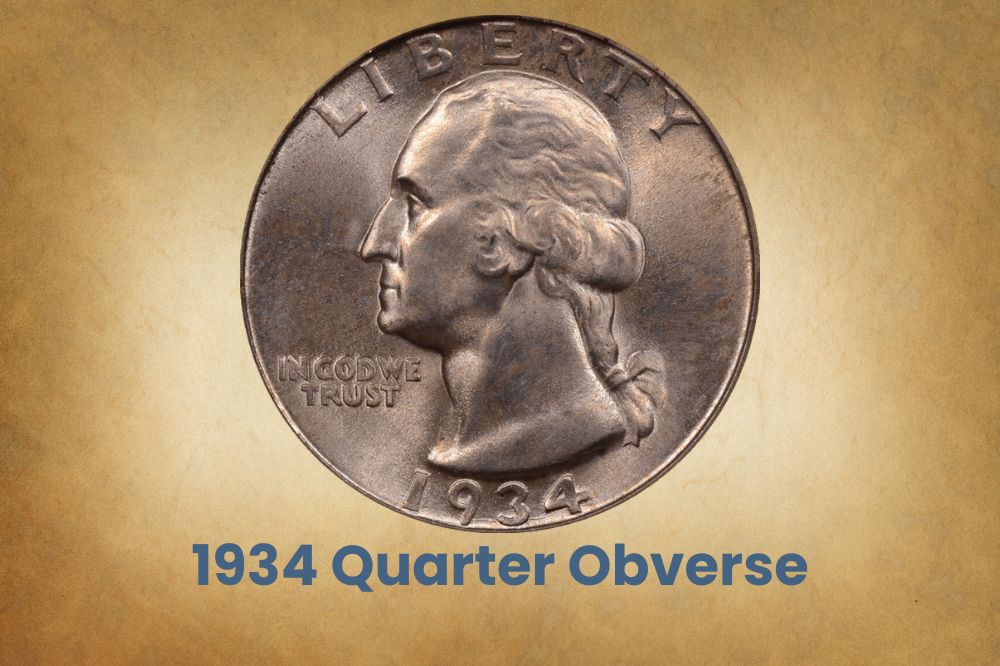
The obverse is the top side of the coin, also known as the heads. In the 1934 quarter, the obverse features the left-facing portrait of former President George Washington with his hair held back in a low ponytail.
The word LIBERTY appears boldly around the top edge of the coin, while the date, 1934, is etched around the coin’s lower edge.
The motto IN GOD WE TRUST appears on the left side of the coin in front of Washington’s neck.
The Reverse Of The 1934 Quarter
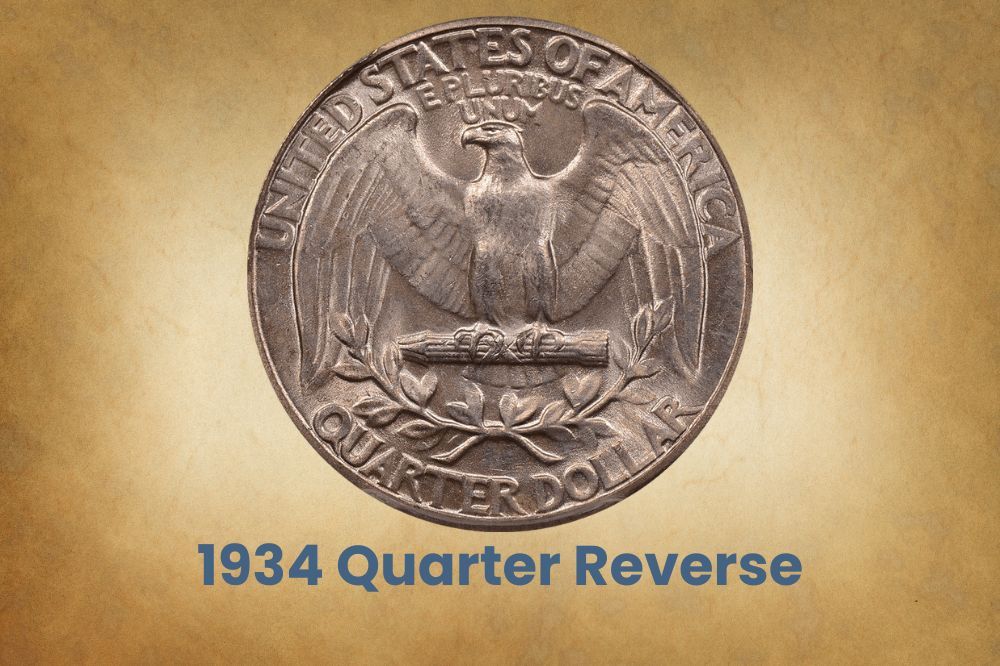
The reverse is the backside of the coin, also known as the tail. In the 1934 quarter, the reverse features a left-facing bald eagle with its wings spread out.
The eagle clutches a bunch of arrows in its talons, believed to represent readiness to defend the Union. Underneath is a single string of olive branches, representing peace and democracy.
The words UNITED STATES OF AMERICA occupy the top edge of the coin. Right underneath is the motto, E PLURIBUS UNUM.
The coin’s denomination, QUARTER DOLLAR, appears around the lower edge of the coin.
Other Features Of The 1934 Quarter
The 1934 quarter was struck at the Philadelphia and Denver mints. The quarters struck in Philadelphia that year did not have a mintmark, while those minted in Denver have a mint mark ‘D.’
The ‘D’ mintmark appears on the coin’s reverse below the string of olive leaves where the two branches are tied together.
The Washington quarter from 1934 is made of 90% silver and 10% copper. The silver content makes this coin worth more than face value.
The coin measures 24.30 mm in diameter and weighs 6.25 grams.
Related Posts: 20 Most Valuable State Quarters Worth Money
How much silver is in a 1934 quarter?
Much like other Washington quarters struck from 1932 to 1965, all 1934 quarters is 90% silver. In particular, they contain 5.6 grams or o.18 troy oz of 0.99 pure silver. This amount of silver is actually very small, making the melt value of a 1934 quarter equally low. Some collectors wrongfully believe they can make a lot of money selling the silver content of a Washington quarter by leveraging the current prices of silver. But as mentioned, the small amount of silver in the coin alone is insufficient to warrant the coin fetching a lot of money.
Is a 1934 silver quarter valuable?
The 1934 silver can be worth quite a lot of money, but this depends on its condition. Quarters in circulated condition, i.e., worn-out coins, are worth a few dollars more than face value. Meanwhile, a 1934 quarter in uncirculated, mint condition can fetch thousands of dollars. It is a good idea to keep your 1934 Washington quarter; not only does it have some monetary value to collectors, but it also has significant historical and sentimental value as it commemorates the birth of the first president of the U.S.A.
Is a 1934 Washington quarter rare?
A Washington quarter from 1934 has numerous examples, especially true for circulated coins- you can easily find these coins in pocket change and collector vaults. That said, quarters in uncirculated condition, whether from the Philly or Denver mint, are fairly scarce and can be worth thousands of dollars.
Related Posts: 21 Most Valuable Quarters In Circulation
